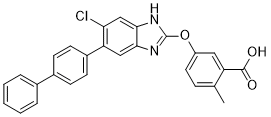MK-3903
This product is for research use only, not for human use. We do not sell to patients.

For small sizes, please check our retail website as below: www.invivochem.com
| Size | Price | Stock |
|---|---|---|
| 250mg | $1150 | Check With Us |
| 500mg | $1750 | Check With Us |
| 1g | $2625 | Check With Us |
Cat #: V4058 CAS #: 1219737-12-8 Purity ≥ 98%
Description: MK-3903 (MK3903) is a novel, potent and selective AMPK (AMP-activated protein kinase) activator with EC50 of 8 nM for α1 β1 γ1 subunit, leading to improved lipid metabolism and insulin sensitization in mice.
Top Publications Citing Invivochem Products
Publications Citing InvivoChem Products
Product Promise

- Physicochemical and Storage Information
- Protocol
- Related Biological Data
- Stock Solution Preparation
- Quality Control Documentation
| Molecular Weight (MW) | 454.91 |
|---|---|
| Molecular Formula | C27H19ClN2O3 |
| CAS No. | 1219737-12-8 |
| Storage | -20℃ for 3 years in powder formr |
| -80℃ for 2 years in solvent | |
| Solubility In Vitro | DMSO: ≥ 90 mg/mLr |
| Water: < 1mg/mLr | |
| Ethanol: < 1mg/mL | |
| SMILES Code | O=C(O)C1=CC(OC2=NC3=CC(C4=CC=C(C5=CC=CC=C5)C=C4)=C(Cl)C=C3N2)=CC=C1C |
| Synonyms | MK3903; MK 3903; MK-3903 |
| Protocol | In Vitro | MK-3903 (compound 42) is a potent and selective AMP-activated protein kinase (AMPK) activator with an EC50 of 8 nM. MK-3903 activates 10 of the 12 phosphorylated AMPK (pAMPK) complexes with EC50 values in the range of 8 to 40 nM and maximal activation >50%. MK-3903 partially activates pAMPK5 (36% max) and it does not activate pAMPK6. MK-3903 demonstrates low permeability (Papp=6×10-6 cm/s) in LLC-PK1 cells42 and is a substrate of human liver uptake transporters OATP1B1 and OATP1B3 (organic anion transporter proteins). Results show that MK-3903 binds moderately to the prostanoid DP2 (CRTH2) receptor (binding IC50=1.8 μM) but not in the presence of 10% human serum (binding IC50>86 μM). |
|---|---|---|
| In Vivo | The pharmacokinetics of MK-3903 (compound 42) in C57BL/6 mice, Sprague to Dawley rats, and beagle dogs are characterized by moderate systemic plasma clearance (5.0 to13 mL/min/kg), a volume of distribution at steady state of 0.6 to 1.1 L/kg, and a terminal halflife of ~2h. Acute oral administration of MK-3903 (3, 10, and 30 mg/kg) to high-fructose fed db/+ mice results in significant inhibition of hepatic fatty acid synthesis (FAS) for all three doses. |
These protocols are for reference only. InvivoChem does not
independently validate these methods.
| Solvent volume to be added | Mass (the weight of a compound) | |||
|---|---|---|---|---|
| Mother liquor concentration | 1mg | 5mg | 10mg | 20mg |
| 1mM | 2.1982 mL | 10.9912 mL | 21.9824 mL | 43.9647 mL |
| 5mM | 0.4396 mL | 2.1982 mL | 4.3965 mL | 8.7929 mL |
| 10mM | 0.2198 mL | 1.0991 mL | 2.1982 mL | 4.3965 mL |
| 20mM | 0.1099 mL | 0.5496 mL | 1.0991 mL | 2.1982 mL |
The molarity calculator equation
Mass(g) = Concentration(mol/L) × Volume(L) × Molecular Weight(g/mol)
Mass
=
Concentration
×
Volume
×
Molecular Weight*
The dilution calculator equation
Concentration(start)
×
Volume(start)
=
Concentration(final)
×
Volume(final)
This equation is commonly abbreviated as: C1 V1 = C2 V2
Concentration(start)
C1
×
Volume(start)
V1
=
Concentration(final)
C2
×
Volume(final)
V2
Step One: Enter information below
Dosage mg/kg
Average weight of animals g
Dosing volume per animal µL
Number of animals
Step Two: Enter the in vivo formulation
%DMSO
+
%
+
%Tween 80
+
%ddH2O
Calculation Results:
Working concentration:
mg/ml;
Method for preparing DMSO master liquid:
mg
drug pre-dissolved in
µL
DMSO(Master liquid concentration
mg/mL)
,Please contact us first if the concentration exceeds the DMSO solubility of the batch of drug.
Method for preparing in vivo formulation:
Take
µL
DMSO master liquid, next add
µL
PEG300, mix and clarify, next add
µL
Tween 80,mix and clarify, next add
µL
ddH2O,mix and clarify.
Note:
- (1) Please be sure that the solution is clear before the addition of next solvent. Dissolution methods like vortex, ultrasound or warming and heat may be used to aid dissolving.
- (2) Be sure to add the solvent(s) in order.




































